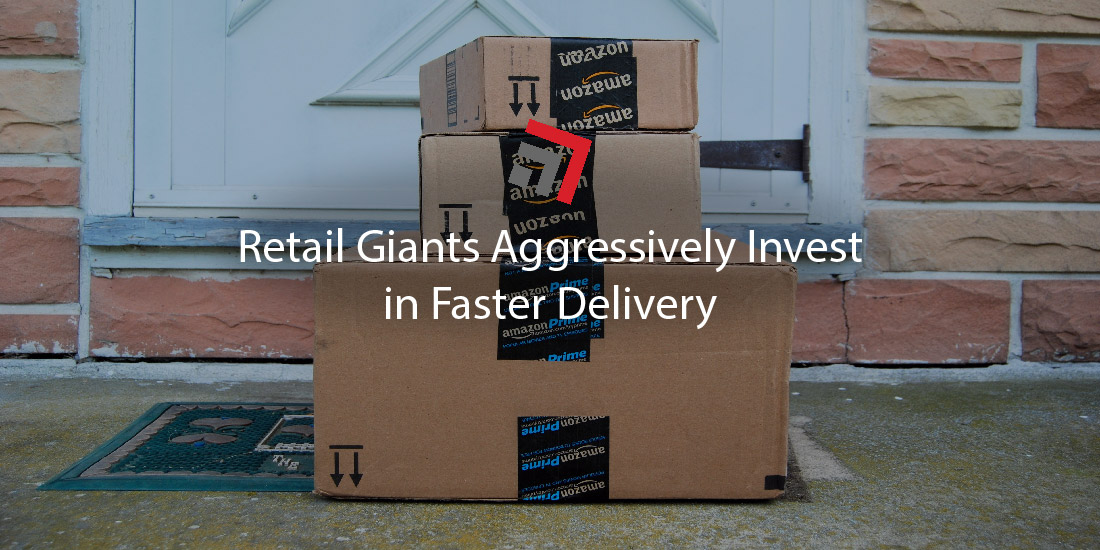Everyone knows a procrastinator or two. Last second shopping for holiday gifts is perhaps one of the more revealing examples of someone putting things off until it’s nearly too late.
Retail giants are aware of this consumer phenomenon and continue to prepare their operations to boost their shipping speeds on last-second orders.
In the modern age, customers are even promised same or next day delivery, often with little or no extra charge.
Amazon, the e-commerce king reigns supreme
Synonymous with fast delivery is retail extraordinaire Amazon. Over the past decade, the Seattle-based e-commerce magnate has revolutionized online shopping for consumers, all while raising the bar on their delivery expectations.
On top of this, Amazon’s premium service Prime offers users free and typically expedited shipping on virtually all orders. This tremendous capability carved Amazon a loyal and converted customer base—in some ways, the retailer’s online vending machine essentially became a monopolized marketplace.
When it comes to e-commerce, Amazon is the gold standard. However, the retailer hasn’t stuck around to smell the roses. It continues to aggressively expand and invest to further improve shipping speeds and optimize distribution.
This sheer ambition is reflected in the company’s new distribution model. Announced last April, this model divvies the U.S. into eight regions and ships packages from warehouses in those areas.
Regionally confined distribution means that shipment orders travel shorter distances with fewer touchpoints, or stops, along the way. When working as intended, this model not only hastens delivery times, but also reduces costs as less labor and assets are involved in these shipments.
Amazon’s previous model also worked off a vast network of warehouses across the country, however the emphasis on containing orders in distinct regions was not as defined.
Amazon leadership echoes confidence in the new model, assuring stakeholders of the retail giant’s results: “We remain on pace to deliver the fastest delivery speeds for Prime customers in our 29-year history,” CEO Andy Jassy stated in an October earnings call.
Amazon executives have also noted the company’s conquest for even faster shipping speeds is driven by expansion of same-day delivery. Certain Prime members are already promised free two-day shipping, but the next frontier appears to be customers receiving the package they ordered within the same day.
That said, the capacity to accomplish such a feat is not presently available. Right now, same-day deliveries are really only possible through orders fulfilled at smaller Amazon warehouses in large metropolitan areas. These facilities typically only store products which are the most demanded by online shoppers.
Currently, Amazon has 55 of these sites across the U.S., however company executives anticipate that this number will double over the next several years.
Walmart beefs up online presence, delivery efficiency
Amazon may be lightyears ahead, but that hasn’t dissuaded another retail giant from playing catch up.
Titan of industry Walmart has been liberally investing in warehouses and other facilities or features that can better optimize its distribution model and delivery speeds.
Walmart, the country’s largest retailer, has retrofitted more than 4,000 of its nationwide stores, adding fulfillment centers and delivery hubs for online orders within these spaces. In 2020, the Arkansas-based company also launched an exclusive membership program Walmart Plus, offering customers ambitious perks, like unlimited free delivery and product discounts when shopping online.
This year, Walmart further upped the ante. So-called parcel stations have been added to stores across nine states in a bid to process more products and expedite their delivery to customers. Company executives say that these stations, which are likened to mini post offices that receive and deliver packages, will be operating during the holiday season.
On a broader scale, Walmart has also been overhauling its distribution centers to implement automating technologies which aim to speed up shipping to stores and customers. At the same time, the company has also opened three fully automated “next generation” fulfillment centers, which store an assortment of products desired most from customers and reduces the number of steps to pack and ship orders.
Final Thoughts
At the end of the day though, it’s apparently futile that Walmart will ever “out-Amazon” Amazon’s model. Like other large retailers, Walmart boasts impressive capacity to improve its presence in online retail, however no company, at least for the foreseeable future, can catch up with what Amazon has built over the decades.
From a sheer numbers perspective, Amazon’s expansive capacity of warehouse space and delivery fleets outweighs any other player in this market.
Contact one of our team members if you have any questions regarding this topic or any others in domestic logistics.
More blogs similar to this:



Recent Comments